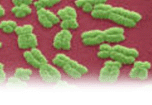MOUSE AND HUMAN ERE DATABASES
Estrogen receptors (ERs) recognize 15 bp palindromic estrogen response elements (EREs) with maximal affinity in vitro. We have screened for high affinity EREs (perfect consensus and elements containing up to two mismatches, selected based on in vitro DNA binding results and sequences of known elements) in the human and mouse genomes , leading to the identification of ~70,000 motifs in the human and mouse genomes. Elements were mapped with respect to mRNA 5’ ends (based on the genome annotations of the NCBI built 33 for the human genome and built 30 for the mouse genome). Please see below for the lists of EREs found in the human and mouse genomes within a range of –10kb to +5kb from mRNA 5'-ends. Comparison of results obtained in the human and mouse genomes led to the identification of putative conserved EREs, defined as EREs in gene orthologues with less than 2kb difference in their respective positions to the mRNA 5'-end in human and mouse orthologs (please see below). Conserved and non-conserved elements were found, often in multiple occurrences, in over 230 estrogen-stimulated human genes previously identified from expression studies. New distal elements were found in genes containing known EREs, some of which have higher binding affinity in vitro and/or are better conserved. Chromatin immunoprecipitation experiments in breast cancer cell lines indicate that most novel elements present in responsive genes bind ER alpha in vivo, including some EREs located up to ~10 kb from transcriptional start sites (please see Bourdeau et al., Mol Endocrinol 2004 18(6) :1411-1427, and Research section) .
- High-affinity EREs found in the Human genome at a range a of –10kb to +5kb from mRNA 5'-ends (as mapped in NCBI built 33).
PDF VERSION EXCEL VERSION
- High-affinity EREs found in the Mouse genome at a range a of –10kb to +5kb from mRNA 5'-ends (as mapped in NCBI built 30).
PDF VERSION EXCEL VERSION
- Conserved EREs (EREs in gene orthologues with less than 2kb difference in their respective positions to the mRNA 5'-end in human and mouse orthologs).
PDF VERSION EXCEL VERSION
Warning : Please note that these files correspond to genome annotations in NCBI built 33 (human genome)
and built 30 (mouse genome). The position of EREs in more recent releases may differ from the indicated ones.
You may request receiving notification of updates of this webpage or sent correspondance to
sylvie.mader@umontreal.ca.
Reference : Bourdeau V, Deschênes J, Metivier R, Nagai Y, Nguyen D, Hudson T, White J, Gannon F, and Mader S. (2004) Mol Endocrinol. 18(6):1411-1427. Genome-wide identification of high-affinity estrogen response elements in human and mouse.
Reference : Bourdeau V, Deschênes J, Metivier R, Nagai Y, Nguyen D, Hudson T, White J, Gannon F, and Mader S. (2004) Mol Endocrinol. 18(6):1411-1427. Genome-wide identification of high-affinity estrogen response elements in human and mouse.










